Understanding the Benefits and Risks of Foreign Labour in Singapore
VerifiedAdded on 2022/11/23
|13
|3171
|61
Essay
AI Summary
This essay delves into the multifaceted issue of foreign labour in Singapore, specifically within the construction industry. It meticulously analyzes the economic benefits derived from the utilization of migrant workers, such as reduced operational costs and contributions to the nation's economic growth, particularly in overcoming labour crises. Furthermore, it highlights the social contributions of foreign workers, including the promotion of multiculturalism and societal reforms. However, the essay also critically assesses the risks associated with this reliance, including potential adverse effects on native workers' employment opportunities, concerns about the skill levels of foreign labourers, and potential social challenges stemming from cultural integration. The essay examines the arguments, supporting them with evidence and references to academic sources, to provide a balanced and comprehensive understanding of the complex interplay between foreign labour, economic development, and social dynamics in Singapore.
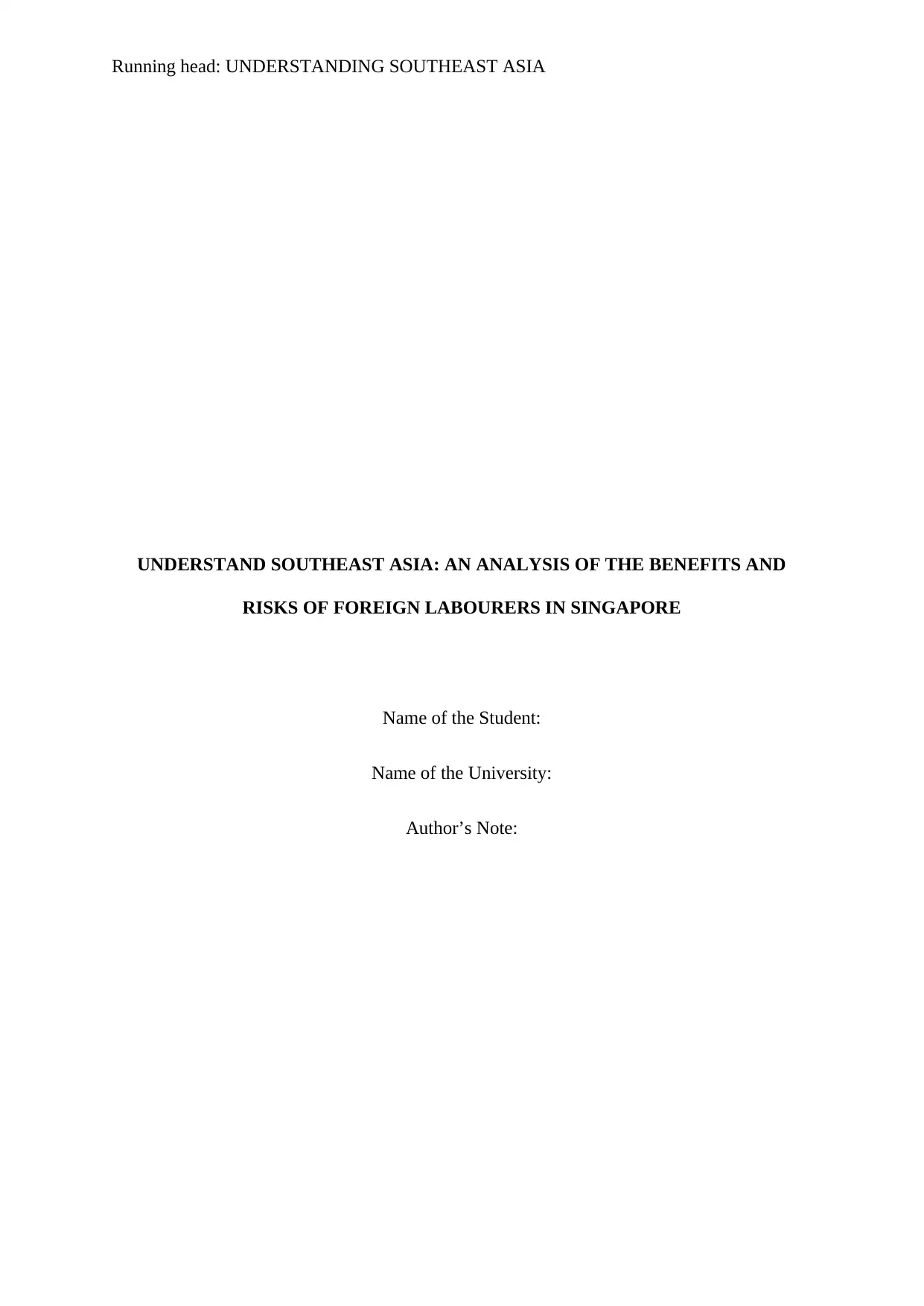
Running head: UNDERSTANDING SOUTHEAST ASIA
UNDERSTAND SOUTHEAST ASIA: AN ANALYSIS OF THE BENEFITS AND
RISKS OF FOREIGN LABOURERS IN SINGAPORE
Name of the Student:
Name of the University:
Author’s Note:
UNDERSTAND SOUTHEAST ASIA: AN ANALYSIS OF THE BENEFITS AND
RISKS OF FOREIGN LABOURERS IN SINGAPORE
Name of the Student:
Name of the University:
Author’s Note:
Paraphrase This Document
Need a fresh take? Get an instant paraphrase of this document with our AI Paraphraser
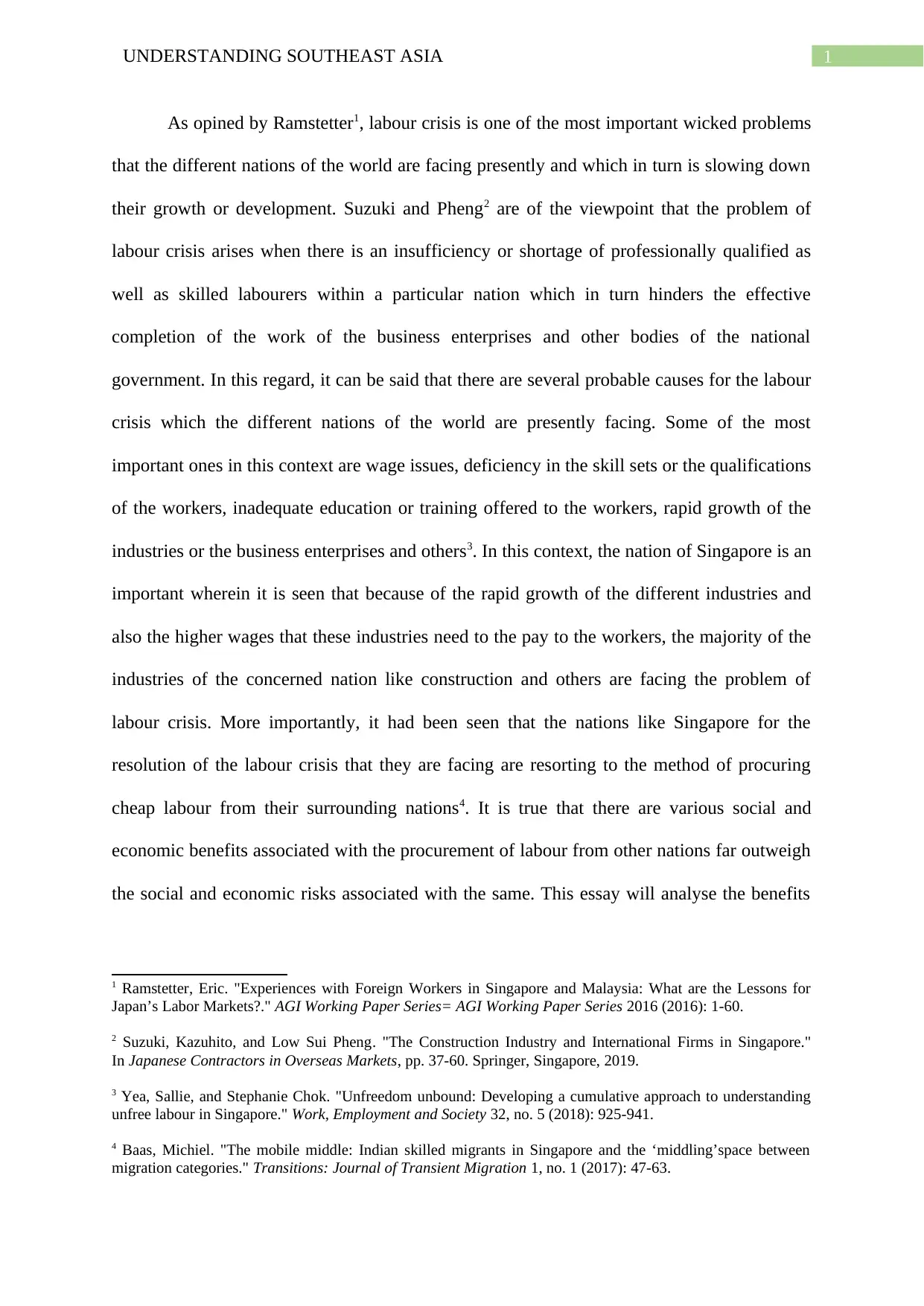
1UNDERSTANDING SOUTHEAST ASIA
As opined by Ramstetter1, labour crisis is one of the most important wicked problems
that the different nations of the world are facing presently and which in turn is slowing down
their growth or development. Suzuki and Pheng2 are of the viewpoint that the problem of
labour crisis arises when there is an insufficiency or shortage of professionally qualified as
well as skilled labourers within a particular nation which in turn hinders the effective
completion of the work of the business enterprises and other bodies of the national
government. In this regard, it can be said that there are several probable causes for the labour
crisis which the different nations of the world are presently facing. Some of the most
important ones in this context are wage issues, deficiency in the skill sets or the qualifications
of the workers, inadequate education or training offered to the workers, rapid growth of the
industries or the business enterprises and others3. In this context, the nation of Singapore is an
important wherein it is seen that because of the rapid growth of the different industries and
also the higher wages that these industries need to the pay to the workers, the majority of the
industries of the concerned nation like construction and others are facing the problem of
labour crisis. More importantly, it had been seen that the nations like Singapore for the
resolution of the labour crisis that they are facing are resorting to the method of procuring
cheap labour from their surrounding nations4. It is true that there are various social and
economic benefits associated with the procurement of labour from other nations far outweigh
the social and economic risks associated with the same. This essay will analyse the benefits
1 Ramstetter, Eric. "Experiences with Foreign Workers in Singapore and Malaysia: What are the Lessons for
Japan’s Labor Markets?." AGI Working Paper Series= AGI Working Paper Series 2016 (2016): 1-60.
2 Suzuki, Kazuhito, and Low Sui Pheng. "The Construction Industry and International Firms in Singapore."
In Japanese Contractors in Overseas Markets, pp. 37-60. Springer, Singapore, 2019.
3 Yea, Sallie, and Stephanie Chok. "Unfreedom unbound: Developing a cumulative approach to understanding
unfree labour in Singapore." Work, Employment and Society 32, no. 5 (2018): 925-941.
4 Baas, Michiel. "The mobile middle: Indian skilled migrants in Singapore and the ‘middling’space between
migration categories." Transitions: Journal of Transient Migration 1, no. 1 (2017): 47-63.
As opined by Ramstetter1, labour crisis is one of the most important wicked problems
that the different nations of the world are facing presently and which in turn is slowing down
their growth or development. Suzuki and Pheng2 are of the viewpoint that the problem of
labour crisis arises when there is an insufficiency or shortage of professionally qualified as
well as skilled labourers within a particular nation which in turn hinders the effective
completion of the work of the business enterprises and other bodies of the national
government. In this regard, it can be said that there are several probable causes for the labour
crisis which the different nations of the world are presently facing. Some of the most
important ones in this context are wage issues, deficiency in the skill sets or the qualifications
of the workers, inadequate education or training offered to the workers, rapid growth of the
industries or the business enterprises and others3. In this context, the nation of Singapore is an
important wherein it is seen that because of the rapid growth of the different industries and
also the higher wages that these industries need to the pay to the workers, the majority of the
industries of the concerned nation like construction and others are facing the problem of
labour crisis. More importantly, it had been seen that the nations like Singapore for the
resolution of the labour crisis that they are facing are resorting to the method of procuring
cheap labour from their surrounding nations4. It is true that there are various social and
economic benefits associated with the procurement of labour from other nations far outweigh
the social and economic risks associated with the same. This essay will analyse the benefits
1 Ramstetter, Eric. "Experiences with Foreign Workers in Singapore and Malaysia: What are the Lessons for
Japan’s Labor Markets?." AGI Working Paper Series= AGI Working Paper Series 2016 (2016): 1-60.
2 Suzuki, Kazuhito, and Low Sui Pheng. "The Construction Industry and International Firms in Singapore."
In Japanese Contractors in Overseas Markets, pp. 37-60. Springer, Singapore, 2019.
3 Yea, Sallie, and Stephanie Chok. "Unfreedom unbound: Developing a cumulative approach to understanding
unfree labour in Singapore." Work, Employment and Society 32, no. 5 (2018): 925-941.
4 Baas, Michiel. "The mobile middle: Indian skilled migrants in Singapore and the ‘middling’space between
migration categories." Transitions: Journal of Transient Migration 1, no. 1 (2017): 47-63.
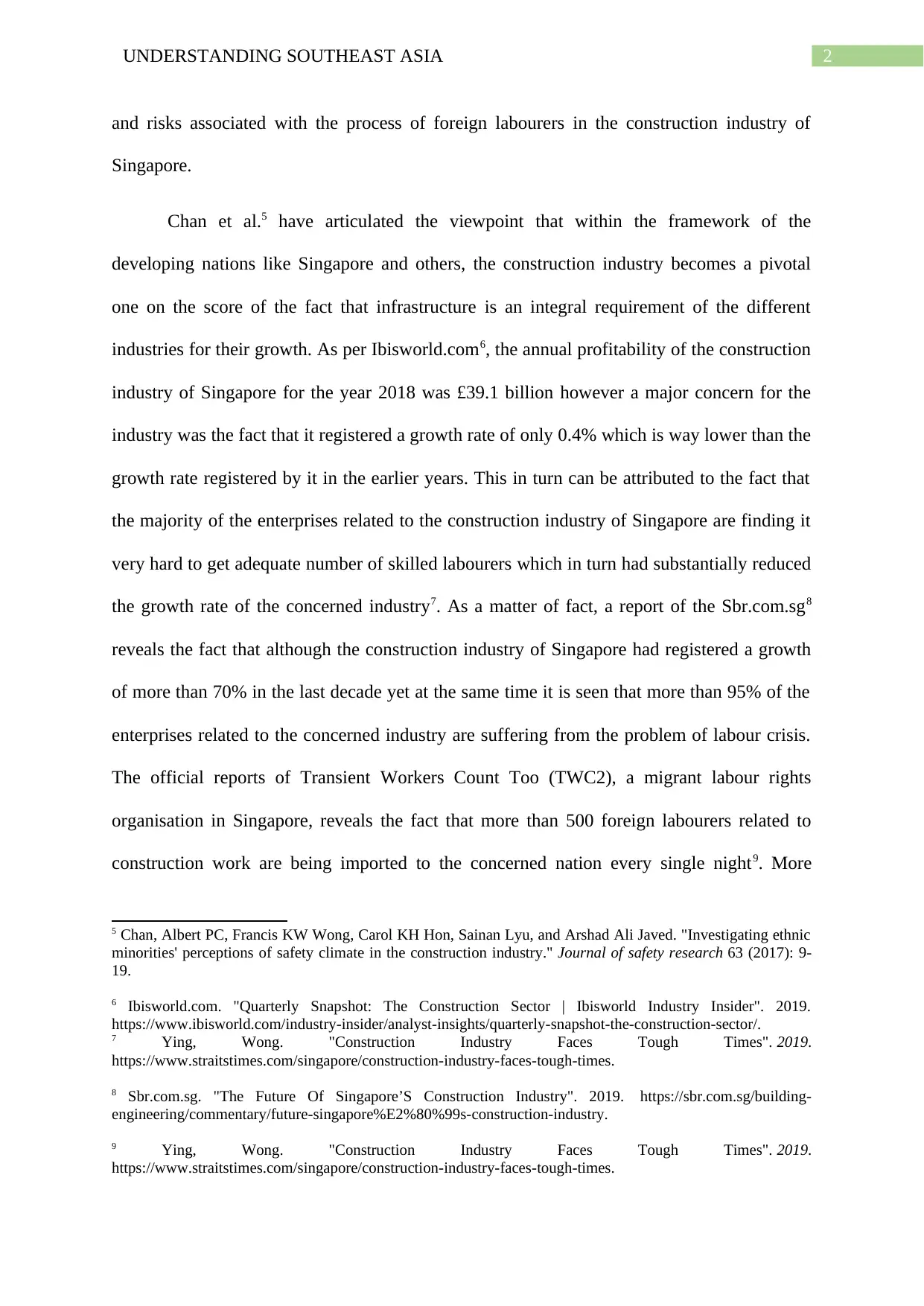
2UNDERSTANDING SOUTHEAST ASIA
and risks associated with the process of foreign labourers in the construction industry of
Singapore.
Chan et al.5 have articulated the viewpoint that within the framework of the
developing nations like Singapore and others, the construction industry becomes a pivotal
one on the score of the fact that infrastructure is an integral requirement of the different
industries for their growth. As per Ibisworld.com6, the annual profitability of the construction
industry of Singapore for the year 2018 was £39.1 billion however a major concern for the
industry was the fact that it registered a growth rate of only 0.4% which is way lower than the
growth rate registered by it in the earlier years. This in turn can be attributed to the fact that
the majority of the enterprises related to the construction industry of Singapore are finding it
very hard to get adequate number of skilled labourers which in turn had substantially reduced
the growth rate of the concerned industry7. As a matter of fact, a report of the Sbr.com.sg8
reveals the fact that although the construction industry of Singapore had registered a growth
of more than 70% in the last decade yet at the same time it is seen that more than 95% of the
enterprises related to the concerned industry are suffering from the problem of labour crisis.
The official reports of Transient Workers Count Too (TWC2), a migrant labour rights
organisation in Singapore, reveals the fact that more than 500 foreign labourers related to
construction work are being imported to the concerned nation every single night9. More
5 Chan, Albert PC, Francis KW Wong, Carol KH Hon, Sainan Lyu, and Arshad Ali Javed. "Investigating ethnic
minorities' perceptions of safety climate in the construction industry." Journal of safety research 63 (2017): 9-
19.
6 Ibisworld.com. "Quarterly Snapshot: The Construction Sector | Ibisworld Industry Insider". 2019.
https://www.ibisworld.com/industry-insider/analyst-insights/quarterly-snapshot-the-construction-sector/.
7 Ying, Wong. "Construction Industry Faces Tough Times". 2019.
https://www.straitstimes.com/singapore/construction-industry-faces-tough-times.
8 Sbr.com.sg. "The Future Of Singapore’S Construction Industry". 2019. https://sbr.com.sg/building-
engineering/commentary/future-singapore%E2%80%99s-construction-industry.
9 Ying, Wong. "Construction Industry Faces Tough Times". 2019.
https://www.straitstimes.com/singapore/construction-industry-faces-tough-times.
and risks associated with the process of foreign labourers in the construction industry of
Singapore.
Chan et al.5 have articulated the viewpoint that within the framework of the
developing nations like Singapore and others, the construction industry becomes a pivotal
one on the score of the fact that infrastructure is an integral requirement of the different
industries for their growth. As per Ibisworld.com6, the annual profitability of the construction
industry of Singapore for the year 2018 was £39.1 billion however a major concern for the
industry was the fact that it registered a growth rate of only 0.4% which is way lower than the
growth rate registered by it in the earlier years. This in turn can be attributed to the fact that
the majority of the enterprises related to the construction industry of Singapore are finding it
very hard to get adequate number of skilled labourers which in turn had substantially reduced
the growth rate of the concerned industry7. As a matter of fact, a report of the Sbr.com.sg8
reveals the fact that although the construction industry of Singapore had registered a growth
of more than 70% in the last decade yet at the same time it is seen that more than 95% of the
enterprises related to the concerned industry are suffering from the problem of labour crisis.
The official reports of Transient Workers Count Too (TWC2), a migrant labour rights
organisation in Singapore, reveals the fact that more than 500 foreign labourers related to
construction work are being imported to the concerned nation every single night9. More
5 Chan, Albert PC, Francis KW Wong, Carol KH Hon, Sainan Lyu, and Arshad Ali Javed. "Investigating ethnic
minorities' perceptions of safety climate in the construction industry." Journal of safety research 63 (2017): 9-
19.
6 Ibisworld.com. "Quarterly Snapshot: The Construction Sector | Ibisworld Industry Insider". 2019.
https://www.ibisworld.com/industry-insider/analyst-insights/quarterly-snapshot-the-construction-sector/.
7 Ying, Wong. "Construction Industry Faces Tough Times". 2019.
https://www.straitstimes.com/singapore/construction-industry-faces-tough-times.
8 Sbr.com.sg. "The Future Of Singapore’S Construction Industry". 2019. https://sbr.com.sg/building-
engineering/commentary/future-singapore%E2%80%99s-construction-industry.
9 Ying, Wong. "Construction Industry Faces Tough Times". 2019.
https://www.straitstimes.com/singapore/construction-industry-faces-tough-times.
⊘ This is a preview!⊘
Do you want full access?
Subscribe today to unlock all pages.

Trusted by 1+ million students worldwide
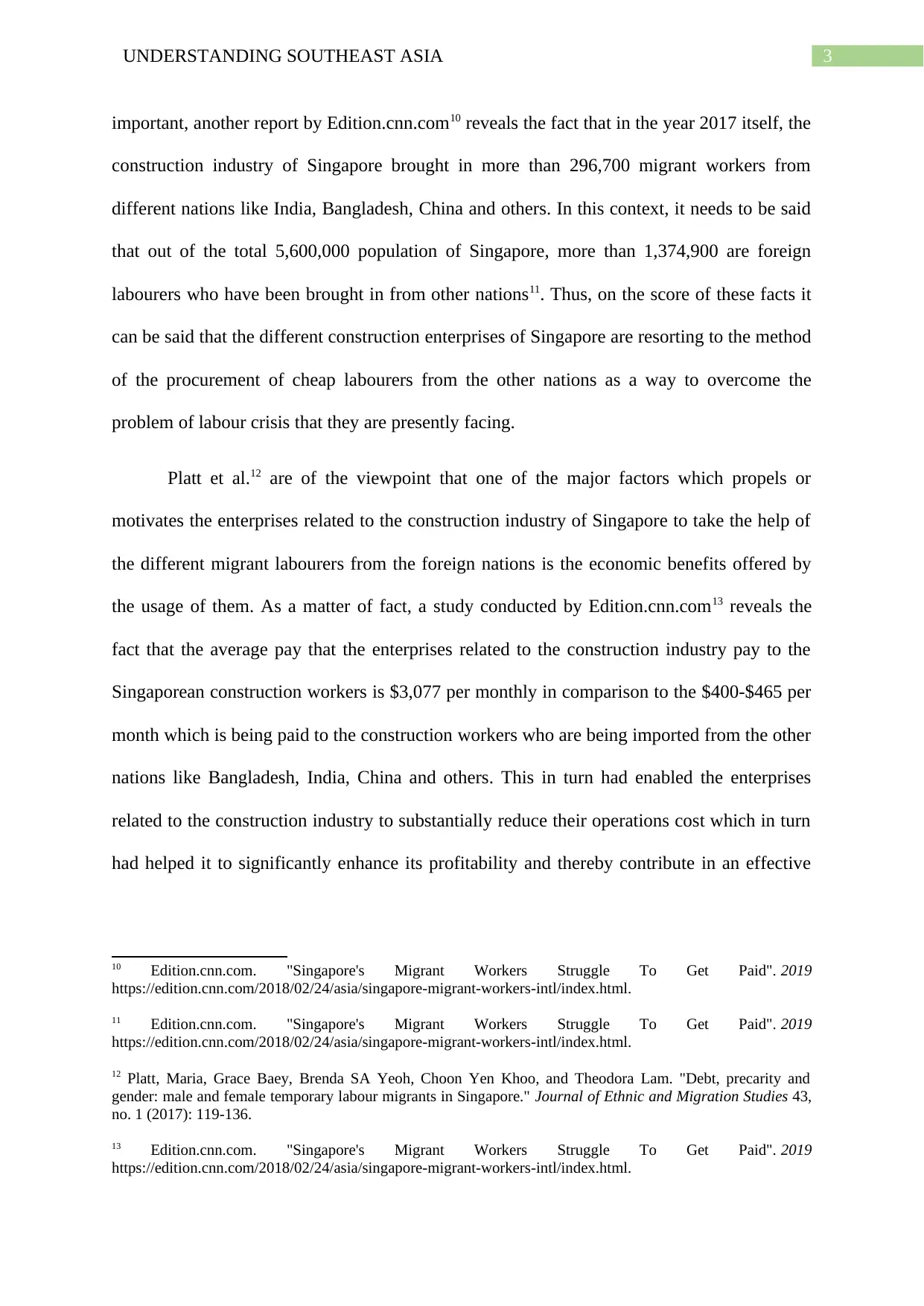
3UNDERSTANDING SOUTHEAST ASIA
important, another report by Edition.cnn.com10 reveals the fact that in the year 2017 itself, the
construction industry of Singapore brought in more than 296,700 migrant workers from
different nations like India, Bangladesh, China and others. In this context, it needs to be said
that out of the total 5,600,000 population of Singapore, more than 1,374,900 are foreign
labourers who have been brought in from other nations11. Thus, on the score of these facts it
can be said that the different construction enterprises of Singapore are resorting to the method
of the procurement of cheap labourers from the other nations as a way to overcome the
problem of labour crisis that they are presently facing.
Platt et al.12 are of the viewpoint that one of the major factors which propels or
motivates the enterprises related to the construction industry of Singapore to take the help of
the different migrant labourers from the foreign nations is the economic benefits offered by
the usage of them. As a matter of fact, a study conducted by Edition.cnn.com13 reveals the
fact that the average pay that the enterprises related to the construction industry pay to the
Singaporean construction workers is $3,077 per monthly in comparison to the $400-$465 per
month which is being paid to the construction workers who are being imported from the other
nations like Bangladesh, India, China and others. This in turn had enabled the enterprises
related to the construction industry to substantially reduce their operations cost which in turn
had helped it to significantly enhance its profitability and thereby contribute in an effective
10 Edition.cnn.com. "Singapore's Migrant Workers Struggle To Get Paid". 2019
https://edition.cnn.com/2018/02/24/asia/singapore-migrant-workers-intl/index.html.
11 Edition.cnn.com. "Singapore's Migrant Workers Struggle To Get Paid". 2019
https://edition.cnn.com/2018/02/24/asia/singapore-migrant-workers-intl/index.html.
12 Platt, Maria, Grace Baey, Brenda SA Yeoh, Choon Yen Khoo, and Theodora Lam. "Debt, precarity and
gender: male and female temporary labour migrants in Singapore." Journal of Ethnic and Migration Studies 43,
no. 1 (2017): 119-136.
13 Edition.cnn.com. "Singapore's Migrant Workers Struggle To Get Paid". 2019
https://edition.cnn.com/2018/02/24/asia/singapore-migrant-workers-intl/index.html.
important, another report by Edition.cnn.com10 reveals the fact that in the year 2017 itself, the
construction industry of Singapore brought in more than 296,700 migrant workers from
different nations like India, Bangladesh, China and others. In this context, it needs to be said
that out of the total 5,600,000 population of Singapore, more than 1,374,900 are foreign
labourers who have been brought in from other nations11. Thus, on the score of these facts it
can be said that the different construction enterprises of Singapore are resorting to the method
of the procurement of cheap labourers from the other nations as a way to overcome the
problem of labour crisis that they are presently facing.
Platt et al.12 are of the viewpoint that one of the major factors which propels or
motivates the enterprises related to the construction industry of Singapore to take the help of
the different migrant labourers from the foreign nations is the economic benefits offered by
the usage of them. As a matter of fact, a study conducted by Edition.cnn.com13 reveals the
fact that the average pay that the enterprises related to the construction industry pay to the
Singaporean construction workers is $3,077 per monthly in comparison to the $400-$465 per
month which is being paid to the construction workers who are being imported from the other
nations like Bangladesh, India, China and others. This in turn had enabled the enterprises
related to the construction industry to substantially reduce their operations cost which in turn
had helped it to significantly enhance its profitability and thereby contribute in an effective
10 Edition.cnn.com. "Singapore's Migrant Workers Struggle To Get Paid". 2019
https://edition.cnn.com/2018/02/24/asia/singapore-migrant-workers-intl/index.html.
11 Edition.cnn.com. "Singapore's Migrant Workers Struggle To Get Paid". 2019
https://edition.cnn.com/2018/02/24/asia/singapore-migrant-workers-intl/index.html.
12 Platt, Maria, Grace Baey, Brenda SA Yeoh, Choon Yen Khoo, and Theodora Lam. "Debt, precarity and
gender: male and female temporary labour migrants in Singapore." Journal of Ethnic and Migration Studies 43,
no. 1 (2017): 119-136.
13 Edition.cnn.com. "Singapore's Migrant Workers Struggle To Get Paid". 2019
https://edition.cnn.com/2018/02/24/asia/singapore-migrant-workers-intl/index.html.
Paraphrase This Document
Need a fresh take? Get an instant paraphrase of this document with our AI Paraphraser
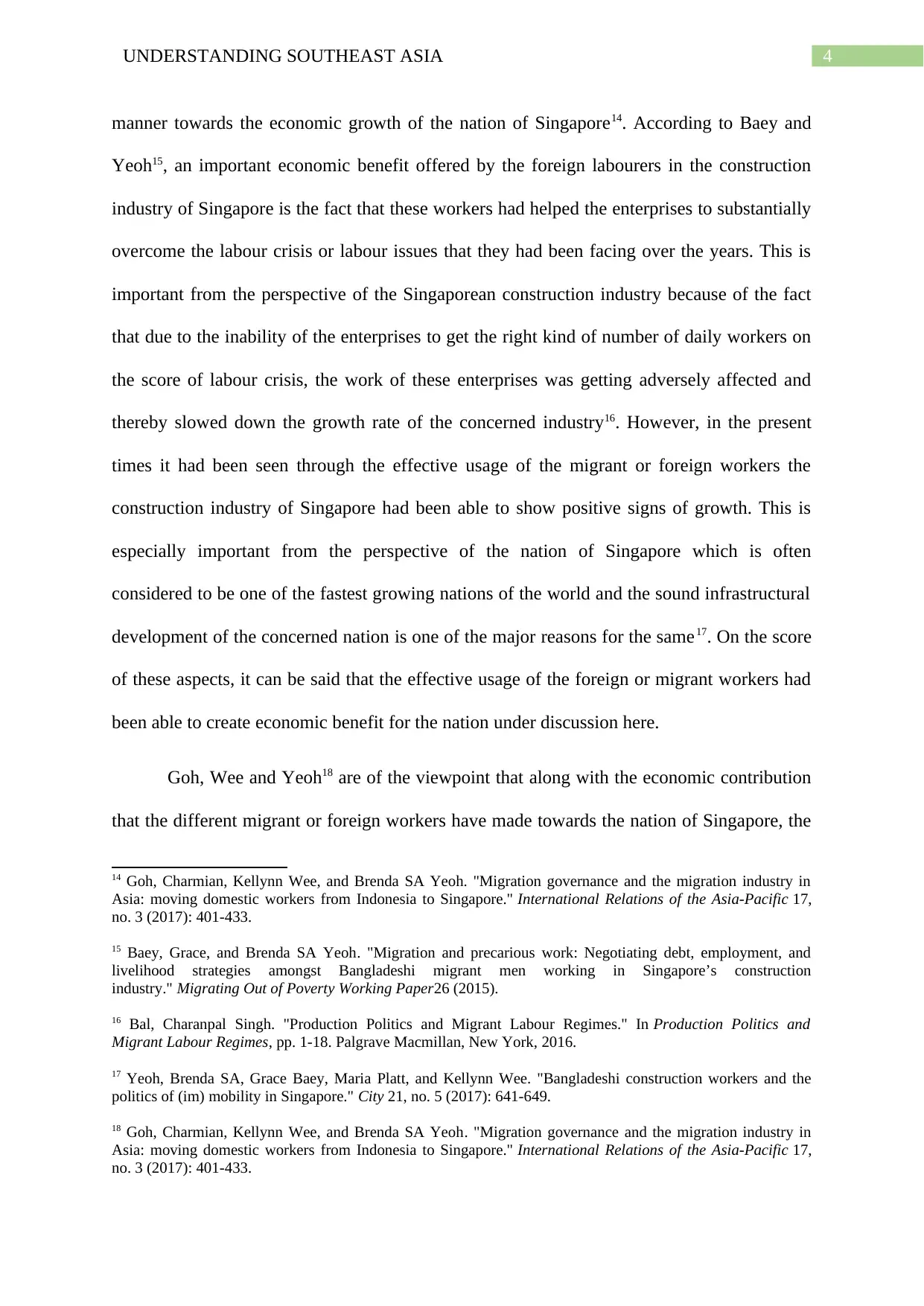
4UNDERSTANDING SOUTHEAST ASIA
manner towards the economic growth of the nation of Singapore14. According to Baey and
Yeoh15, an important economic benefit offered by the foreign labourers in the construction
industry of Singapore is the fact that these workers had helped the enterprises to substantially
overcome the labour crisis or labour issues that they had been facing over the years. This is
important from the perspective of the Singaporean construction industry because of the fact
that due to the inability of the enterprises to get the right kind of number of daily workers on
the score of labour crisis, the work of these enterprises was getting adversely affected and
thereby slowed down the growth rate of the concerned industry16. However, in the present
times it had been seen through the effective usage of the migrant or foreign workers the
construction industry of Singapore had been able to show positive signs of growth. This is
especially important from the perspective of the nation of Singapore which is often
considered to be one of the fastest growing nations of the world and the sound infrastructural
development of the concerned nation is one of the major reasons for the same17. On the score
of these aspects, it can be said that the effective usage of the foreign or migrant workers had
been able to create economic benefit for the nation under discussion here.
Goh, Wee and Yeoh18 are of the viewpoint that along with the economic contribution
that the different migrant or foreign workers have made towards the nation of Singapore, the
14 Goh, Charmian, Kellynn Wee, and Brenda SA Yeoh. "Migration governance and the migration industry in
Asia: moving domestic workers from Indonesia to Singapore." International Relations of the Asia-Pacific 17,
no. 3 (2017): 401-433.
15 Baey, Grace, and Brenda SA Yeoh. "Migration and precarious work: Negotiating debt, employment, and
livelihood strategies amongst Bangladeshi migrant men working in Singapore’s construction
industry." Migrating Out of Poverty Working Paper26 (2015).
16 Bal, Charanpal Singh. "Production Politics and Migrant Labour Regimes." In Production Politics and
Migrant Labour Regimes, pp. 1-18. Palgrave Macmillan, New York, 2016.
17 Yeoh, Brenda SA, Grace Baey, Maria Platt, and Kellynn Wee. "Bangladeshi construction workers and the
politics of (im) mobility in Singapore." City 21, no. 5 (2017): 641-649.
18 Goh, Charmian, Kellynn Wee, and Brenda SA Yeoh. "Migration governance and the migration industry in
Asia: moving domestic workers from Indonesia to Singapore." International Relations of the Asia-Pacific 17,
no. 3 (2017): 401-433.
manner towards the economic growth of the nation of Singapore14. According to Baey and
Yeoh15, an important economic benefit offered by the foreign labourers in the construction
industry of Singapore is the fact that these workers had helped the enterprises to substantially
overcome the labour crisis or labour issues that they had been facing over the years. This is
important from the perspective of the Singaporean construction industry because of the fact
that due to the inability of the enterprises to get the right kind of number of daily workers on
the score of labour crisis, the work of these enterprises was getting adversely affected and
thereby slowed down the growth rate of the concerned industry16. However, in the present
times it had been seen through the effective usage of the migrant or foreign workers the
construction industry of Singapore had been able to show positive signs of growth. This is
especially important from the perspective of the nation of Singapore which is often
considered to be one of the fastest growing nations of the world and the sound infrastructural
development of the concerned nation is one of the major reasons for the same17. On the score
of these aspects, it can be said that the effective usage of the foreign or migrant workers had
been able to create economic benefit for the nation under discussion here.
Goh, Wee and Yeoh18 are of the viewpoint that along with the economic contribution
that the different migrant or foreign workers have made towards the nation of Singapore, the
14 Goh, Charmian, Kellynn Wee, and Brenda SA Yeoh. "Migration governance and the migration industry in
Asia: moving domestic workers from Indonesia to Singapore." International Relations of the Asia-Pacific 17,
no. 3 (2017): 401-433.
15 Baey, Grace, and Brenda SA Yeoh. "Migration and precarious work: Negotiating debt, employment, and
livelihood strategies amongst Bangladeshi migrant men working in Singapore’s construction
industry." Migrating Out of Poverty Working Paper26 (2015).
16 Bal, Charanpal Singh. "Production Politics and Migrant Labour Regimes." In Production Politics and
Migrant Labour Regimes, pp. 1-18. Palgrave Macmillan, New York, 2016.
17 Yeoh, Brenda SA, Grace Baey, Maria Platt, and Kellynn Wee. "Bangladeshi construction workers and the
politics of (im) mobility in Singapore." City 21, no. 5 (2017): 641-649.
18 Goh, Charmian, Kellynn Wee, and Brenda SA Yeoh. "Migration governance and the migration industry in
Asia: moving domestic workers from Indonesia to Singapore." International Relations of the Asia-Pacific 17,
no. 3 (2017): 401-433.
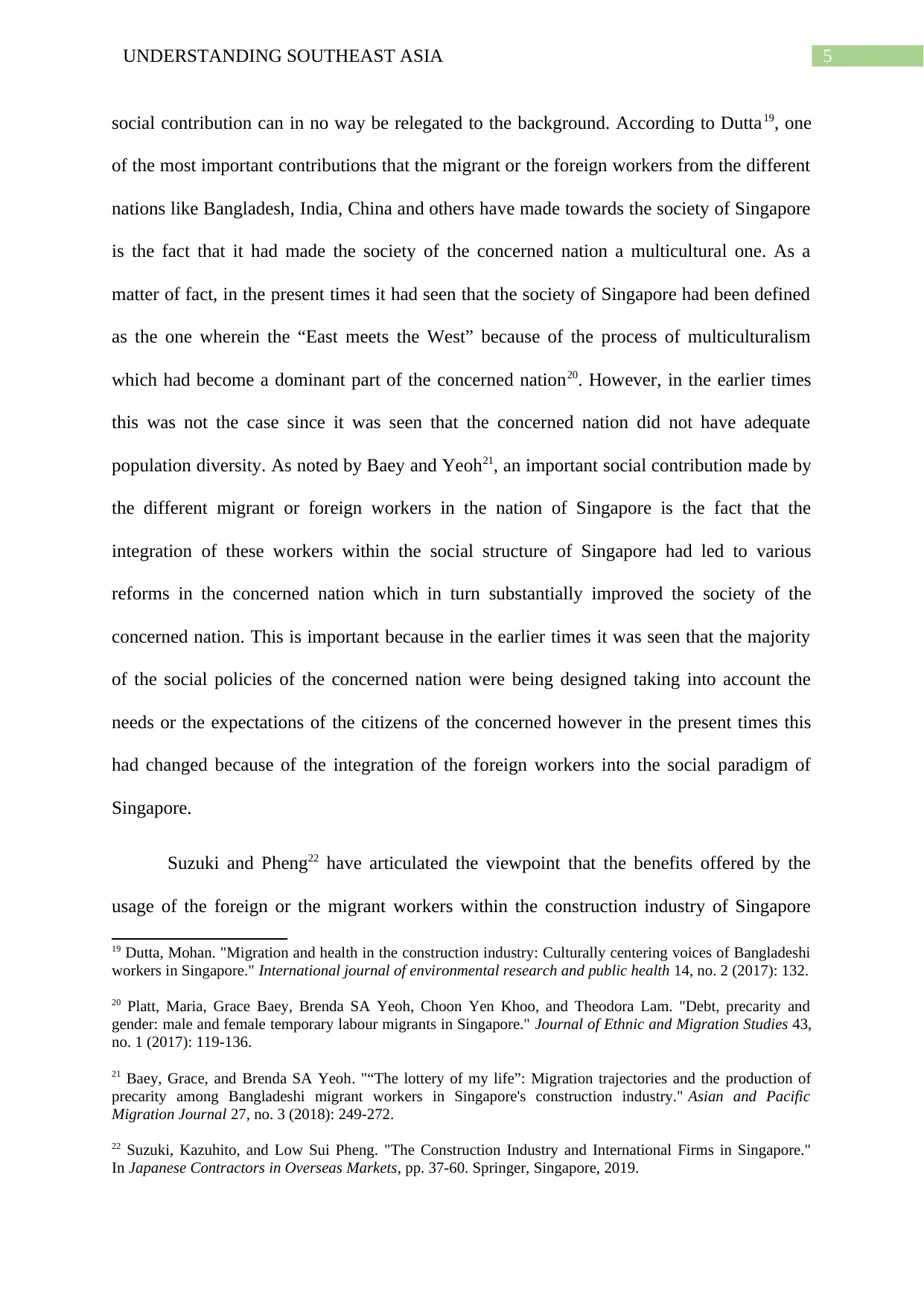
5UNDERSTANDING SOUTHEAST ASIA
social contribution can in no way be relegated to the background. According to Dutta19, one
of the most important contributions that the migrant or the foreign workers from the different
nations like Bangladesh, India, China and others have made towards the society of Singapore
is the fact that it had made the society of the concerned nation a multicultural one. As a
matter of fact, in the present times it had seen that the society of Singapore had been defined
as the one wherein the “East meets the West” because of the process of multiculturalism
which had become a dominant part of the concerned nation20. However, in the earlier times
this was not the case since it was seen that the concerned nation did not have adequate
population diversity. As noted by Baey and Yeoh21, an important social contribution made by
the different migrant or foreign workers in the nation of Singapore is the fact that the
integration of these workers within the social structure of Singapore had led to various
reforms in the concerned nation which in turn substantially improved the society of the
concerned nation. This is important because in the earlier times it was seen that the majority
of the social policies of the concerned nation were being designed taking into account the
needs or the expectations of the citizens of the concerned however in the present times this
had changed because of the integration of the foreign workers into the social paradigm of
Singapore.
Suzuki and Pheng22 have articulated the viewpoint that the benefits offered by the
usage of the foreign or the migrant workers within the construction industry of Singapore
19 Dutta, Mohan. "Migration and health in the construction industry: Culturally centering voices of Bangladeshi
workers in Singapore." International journal of environmental research and public health 14, no. 2 (2017): 132.
20 Platt, Maria, Grace Baey, Brenda SA Yeoh, Choon Yen Khoo, and Theodora Lam. "Debt, precarity and
gender: male and female temporary labour migrants in Singapore." Journal of Ethnic and Migration Studies 43,
no. 1 (2017): 119-136.
21 Baey, Grace, and Brenda SA Yeoh. "“The lottery of my life”: Migration trajectories and the production of
precarity among Bangladeshi migrant workers in Singapore's construction industry." Asian and Pacific
Migration Journal 27, no. 3 (2018): 249-272.
22 Suzuki, Kazuhito, and Low Sui Pheng. "The Construction Industry and International Firms in Singapore."
In Japanese Contractors in Overseas Markets, pp. 37-60. Springer, Singapore, 2019.
social contribution can in no way be relegated to the background. According to Dutta19, one
of the most important contributions that the migrant or the foreign workers from the different
nations like Bangladesh, India, China and others have made towards the society of Singapore
is the fact that it had made the society of the concerned nation a multicultural one. As a
matter of fact, in the present times it had seen that the society of Singapore had been defined
as the one wherein the “East meets the West” because of the process of multiculturalism
which had become a dominant part of the concerned nation20. However, in the earlier times
this was not the case since it was seen that the concerned nation did not have adequate
population diversity. As noted by Baey and Yeoh21, an important social contribution made by
the different migrant or foreign workers in the nation of Singapore is the fact that the
integration of these workers within the social structure of Singapore had led to various
reforms in the concerned nation which in turn substantially improved the society of the
concerned nation. This is important because in the earlier times it was seen that the majority
of the social policies of the concerned nation were being designed taking into account the
needs or the expectations of the citizens of the concerned however in the present times this
had changed because of the integration of the foreign workers into the social paradigm of
Singapore.
Suzuki and Pheng22 have articulated the viewpoint that the benefits offered by the
usage of the foreign or the migrant workers within the construction industry of Singapore
19 Dutta, Mohan. "Migration and health in the construction industry: Culturally centering voices of Bangladeshi
workers in Singapore." International journal of environmental research and public health 14, no. 2 (2017): 132.
20 Platt, Maria, Grace Baey, Brenda SA Yeoh, Choon Yen Khoo, and Theodora Lam. "Debt, precarity and
gender: male and female temporary labour migrants in Singapore." Journal of Ethnic and Migration Studies 43,
no. 1 (2017): 119-136.
21 Baey, Grace, and Brenda SA Yeoh. "“The lottery of my life”: Migration trajectories and the production of
precarity among Bangladeshi migrant workers in Singapore's construction industry." Asian and Pacific
Migration Journal 27, no. 3 (2018): 249-272.
22 Suzuki, Kazuhito, and Low Sui Pheng. "The Construction Industry and International Firms in Singapore."
In Japanese Contractors in Overseas Markets, pp. 37-60. Springer, Singapore, 2019.
⊘ This is a preview!⊘
Do you want full access?
Subscribe today to unlock all pages.

Trusted by 1+ million students worldwide
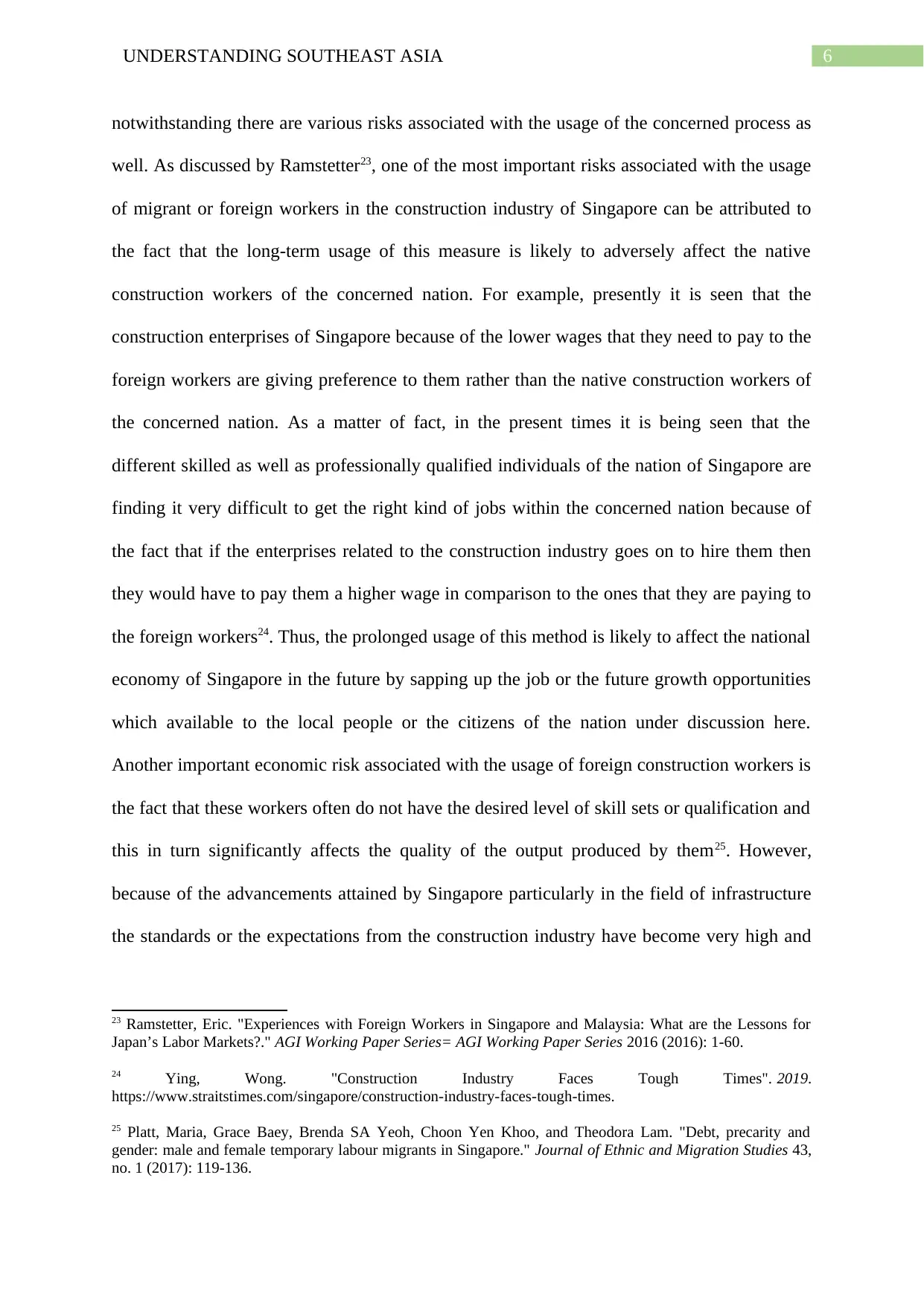
6UNDERSTANDING SOUTHEAST ASIA
notwithstanding there are various risks associated with the usage of the concerned process as
well. As discussed by Ramstetter23, one of the most important risks associated with the usage
of migrant or foreign workers in the construction industry of Singapore can be attributed to
the fact that the long-term usage of this measure is likely to adversely affect the native
construction workers of the concerned nation. For example, presently it is seen that the
construction enterprises of Singapore because of the lower wages that they need to pay to the
foreign workers are giving preference to them rather than the native construction workers of
the concerned nation. As a matter of fact, in the present times it is being seen that the
different skilled as well as professionally qualified individuals of the nation of Singapore are
finding it very difficult to get the right kind of jobs within the concerned nation because of
the fact that if the enterprises related to the construction industry goes on to hire them then
they would have to pay them a higher wage in comparison to the ones that they are paying to
the foreign workers24. Thus, the prolonged usage of this method is likely to affect the national
economy of Singapore in the future by sapping up the job or the future growth opportunities
which available to the local people or the citizens of the nation under discussion here.
Another important economic risk associated with the usage of foreign construction workers is
the fact that these workers often do not have the desired level of skill sets or qualification and
this in turn significantly affects the quality of the output produced by them25. However,
because of the advancements attained by Singapore particularly in the field of infrastructure
the standards or the expectations from the construction industry have become very high and
23 Ramstetter, Eric. "Experiences with Foreign Workers in Singapore and Malaysia: What are the Lessons for
Japan’s Labor Markets?." AGI Working Paper Series= AGI Working Paper Series 2016 (2016): 1-60.
24 Ying, Wong. "Construction Industry Faces Tough Times". 2019.
https://www.straitstimes.com/singapore/construction-industry-faces-tough-times.
25 Platt, Maria, Grace Baey, Brenda SA Yeoh, Choon Yen Khoo, and Theodora Lam. "Debt, precarity and
gender: male and female temporary labour migrants in Singapore." Journal of Ethnic and Migration Studies 43,
no. 1 (2017): 119-136.
notwithstanding there are various risks associated with the usage of the concerned process as
well. As discussed by Ramstetter23, one of the most important risks associated with the usage
of migrant or foreign workers in the construction industry of Singapore can be attributed to
the fact that the long-term usage of this measure is likely to adversely affect the native
construction workers of the concerned nation. For example, presently it is seen that the
construction enterprises of Singapore because of the lower wages that they need to pay to the
foreign workers are giving preference to them rather than the native construction workers of
the concerned nation. As a matter of fact, in the present times it is being seen that the
different skilled as well as professionally qualified individuals of the nation of Singapore are
finding it very difficult to get the right kind of jobs within the concerned nation because of
the fact that if the enterprises related to the construction industry goes on to hire them then
they would have to pay them a higher wage in comparison to the ones that they are paying to
the foreign workers24. Thus, the prolonged usage of this method is likely to affect the national
economy of Singapore in the future by sapping up the job or the future growth opportunities
which available to the local people or the citizens of the nation under discussion here.
Another important economic risk associated with the usage of foreign construction workers is
the fact that these workers often do not have the desired level of skill sets or qualification and
this in turn significantly affects the quality of the output produced by them25. However,
because of the advancements attained by Singapore particularly in the field of infrastructure
the standards or the expectations from the construction industry have become very high and
23 Ramstetter, Eric. "Experiences with Foreign Workers in Singapore and Malaysia: What are the Lessons for
Japan’s Labor Markets?." AGI Working Paper Series= AGI Working Paper Series 2016 (2016): 1-60.
24 Ying, Wong. "Construction Industry Faces Tough Times". 2019.
https://www.straitstimes.com/singapore/construction-industry-faces-tough-times.
25 Platt, Maria, Grace Baey, Brenda SA Yeoh, Choon Yen Khoo, and Theodora Lam. "Debt, precarity and
gender: male and female temporary labour migrants in Singapore." Journal of Ethnic and Migration Studies 43,
no. 1 (2017): 119-136.
Paraphrase This Document
Need a fresh take? Get an instant paraphrase of this document with our AI Paraphraser
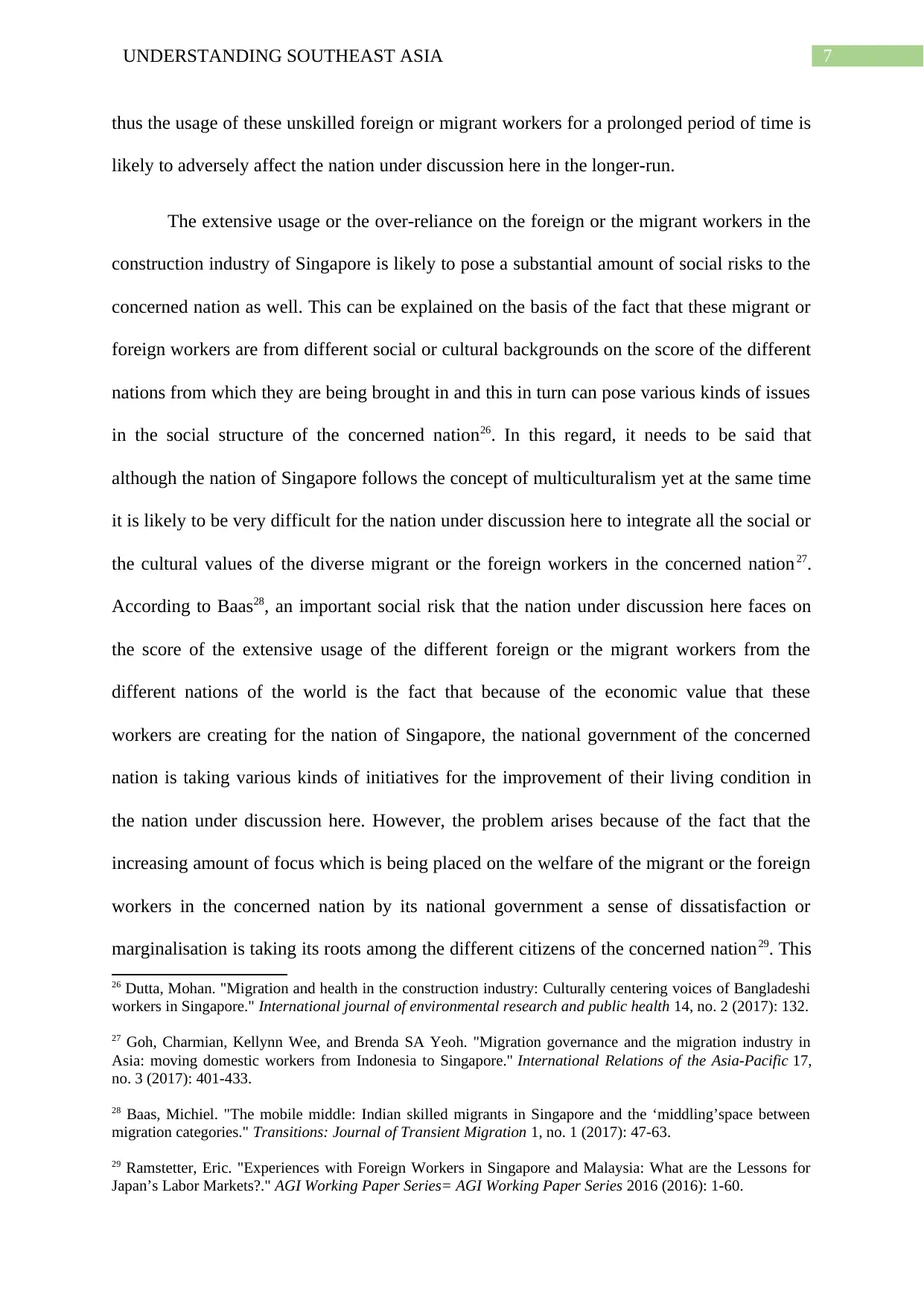
7UNDERSTANDING SOUTHEAST ASIA
thus the usage of these unskilled foreign or migrant workers for a prolonged period of time is
likely to adversely affect the nation under discussion here in the longer-run.
The extensive usage or the over-reliance on the foreign or the migrant workers in the
construction industry of Singapore is likely to pose a substantial amount of social risks to the
concerned nation as well. This can be explained on the basis of the fact that these migrant or
foreign workers are from different social or cultural backgrounds on the score of the different
nations from which they are being brought in and this in turn can pose various kinds of issues
in the social structure of the concerned nation26. In this regard, it needs to be said that
although the nation of Singapore follows the concept of multiculturalism yet at the same time
it is likely to be very difficult for the nation under discussion here to integrate all the social or
the cultural values of the diverse migrant or the foreign workers in the concerned nation27.
According to Baas28, an important social risk that the nation under discussion here faces on
the score of the extensive usage of the different foreign or the migrant workers from the
different nations of the world is the fact that because of the economic value that these
workers are creating for the nation of Singapore, the national government of the concerned
nation is taking various kinds of initiatives for the improvement of their living condition in
the nation under discussion here. However, the problem arises because of the fact that the
increasing amount of focus which is being placed on the welfare of the migrant or the foreign
workers in the concerned nation by its national government a sense of dissatisfaction or
marginalisation is taking its roots among the different citizens of the concerned nation29. This
26 Dutta, Mohan. "Migration and health in the construction industry: Culturally centering voices of Bangladeshi
workers in Singapore." International journal of environmental research and public health 14, no. 2 (2017): 132.
27 Goh, Charmian, Kellynn Wee, and Brenda SA Yeoh. "Migration governance and the migration industry in
Asia: moving domestic workers from Indonesia to Singapore." International Relations of the Asia-Pacific 17,
no. 3 (2017): 401-433.
28 Baas, Michiel. "The mobile middle: Indian skilled migrants in Singapore and the ‘middling’space between
migration categories." Transitions: Journal of Transient Migration 1, no. 1 (2017): 47-63.
29 Ramstetter, Eric. "Experiences with Foreign Workers in Singapore and Malaysia: What are the Lessons for
Japan’s Labor Markets?." AGI Working Paper Series= AGI Working Paper Series 2016 (2016): 1-60.
thus the usage of these unskilled foreign or migrant workers for a prolonged period of time is
likely to adversely affect the nation under discussion here in the longer-run.
The extensive usage or the over-reliance on the foreign or the migrant workers in the
construction industry of Singapore is likely to pose a substantial amount of social risks to the
concerned nation as well. This can be explained on the basis of the fact that these migrant or
foreign workers are from different social or cultural backgrounds on the score of the different
nations from which they are being brought in and this in turn can pose various kinds of issues
in the social structure of the concerned nation26. In this regard, it needs to be said that
although the nation of Singapore follows the concept of multiculturalism yet at the same time
it is likely to be very difficult for the nation under discussion here to integrate all the social or
the cultural values of the diverse migrant or the foreign workers in the concerned nation27.
According to Baas28, an important social risk that the nation under discussion here faces on
the score of the extensive usage of the different foreign or the migrant workers from the
different nations of the world is the fact that because of the economic value that these
workers are creating for the nation of Singapore, the national government of the concerned
nation is taking various kinds of initiatives for the improvement of their living condition in
the nation under discussion here. However, the problem arises because of the fact that the
increasing amount of focus which is being placed on the welfare of the migrant or the foreign
workers in the concerned nation by its national government a sense of dissatisfaction or
marginalisation is taking its roots among the different citizens of the concerned nation29. This
26 Dutta, Mohan. "Migration and health in the construction industry: Culturally centering voices of Bangladeshi
workers in Singapore." International journal of environmental research and public health 14, no. 2 (2017): 132.
27 Goh, Charmian, Kellynn Wee, and Brenda SA Yeoh. "Migration governance and the migration industry in
Asia: moving domestic workers from Indonesia to Singapore." International Relations of the Asia-Pacific 17,
no. 3 (2017): 401-433.
28 Baas, Michiel. "The mobile middle: Indian skilled migrants in Singapore and the ‘middling’space between
migration categories." Transitions: Journal of Transient Migration 1, no. 1 (2017): 47-63.
29 Ramstetter, Eric. "Experiences with Foreign Workers in Singapore and Malaysia: What are the Lessons for
Japan’s Labor Markets?." AGI Working Paper Series= AGI Working Paper Series 2016 (2016): 1-60.
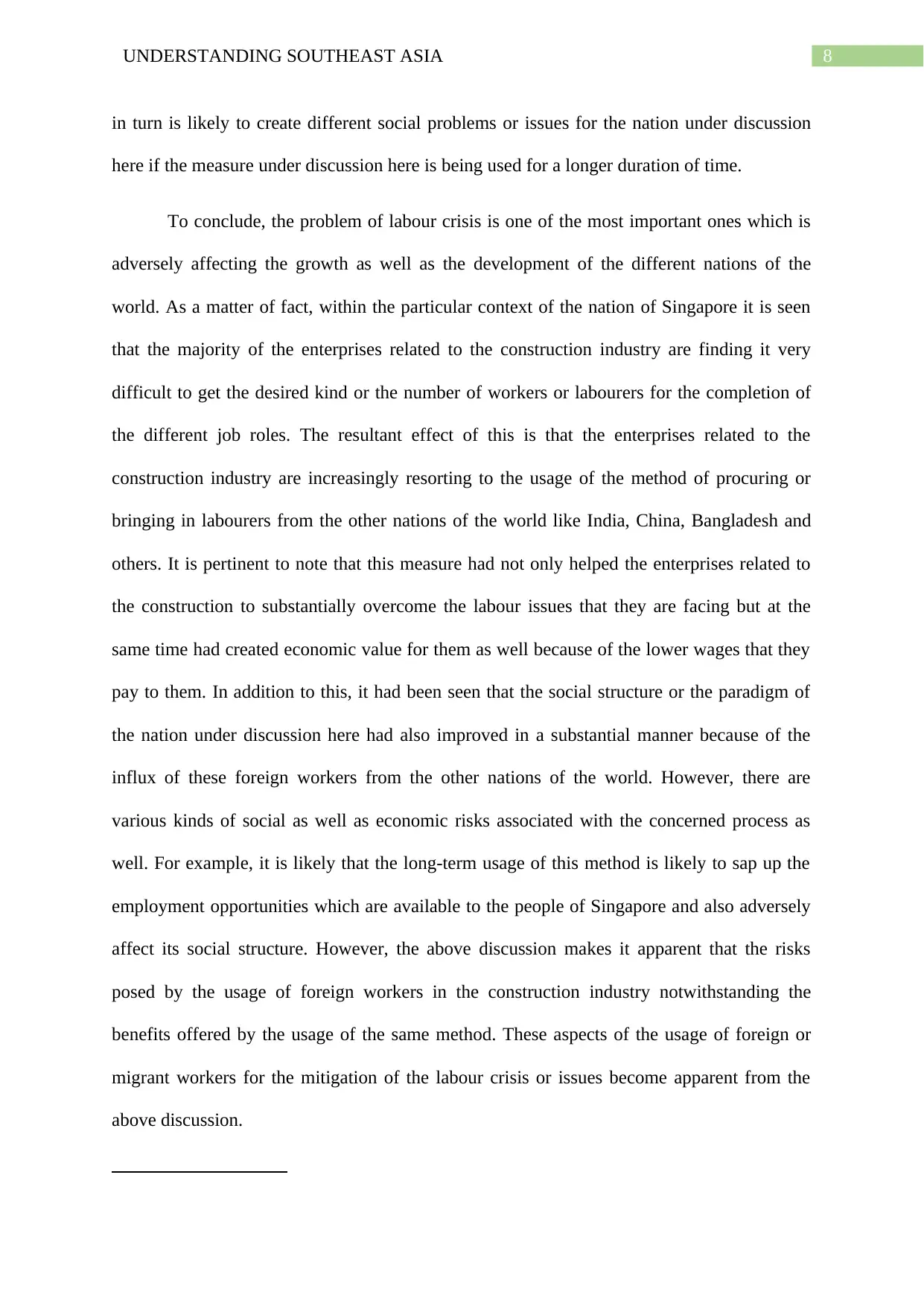
8UNDERSTANDING SOUTHEAST ASIA
in turn is likely to create different social problems or issues for the nation under discussion
here if the measure under discussion here is being used for a longer duration of time.
To conclude, the problem of labour crisis is one of the most important ones which is
adversely affecting the growth as well as the development of the different nations of the
world. As a matter of fact, within the particular context of the nation of Singapore it is seen
that the majority of the enterprises related to the construction industry are finding it very
difficult to get the desired kind or the number of workers or labourers for the completion of
the different job roles. The resultant effect of this is that the enterprises related to the
construction industry are increasingly resorting to the usage of the method of procuring or
bringing in labourers from the other nations of the world like India, China, Bangladesh and
others. It is pertinent to note that this measure had not only helped the enterprises related to
the construction to substantially overcome the labour issues that they are facing but at the
same time had created economic value for them as well because of the lower wages that they
pay to them. In addition to this, it had been seen that the social structure or the paradigm of
the nation under discussion here had also improved in a substantial manner because of the
influx of these foreign workers from the other nations of the world. However, there are
various kinds of social as well as economic risks associated with the concerned process as
well. For example, it is likely that the long-term usage of this method is likely to sap up the
employment opportunities which are available to the people of Singapore and also adversely
affect its social structure. However, the above discussion makes it apparent that the risks
posed by the usage of foreign workers in the construction industry notwithstanding the
benefits offered by the usage of the same method. These aspects of the usage of foreign or
migrant workers for the mitigation of the labour crisis or issues become apparent from the
above discussion.
in turn is likely to create different social problems or issues for the nation under discussion
here if the measure under discussion here is being used for a longer duration of time.
To conclude, the problem of labour crisis is one of the most important ones which is
adversely affecting the growth as well as the development of the different nations of the
world. As a matter of fact, within the particular context of the nation of Singapore it is seen
that the majority of the enterprises related to the construction industry are finding it very
difficult to get the desired kind or the number of workers or labourers for the completion of
the different job roles. The resultant effect of this is that the enterprises related to the
construction industry are increasingly resorting to the usage of the method of procuring or
bringing in labourers from the other nations of the world like India, China, Bangladesh and
others. It is pertinent to note that this measure had not only helped the enterprises related to
the construction to substantially overcome the labour issues that they are facing but at the
same time had created economic value for them as well because of the lower wages that they
pay to them. In addition to this, it had been seen that the social structure or the paradigm of
the nation under discussion here had also improved in a substantial manner because of the
influx of these foreign workers from the other nations of the world. However, there are
various kinds of social as well as economic risks associated with the concerned process as
well. For example, it is likely that the long-term usage of this method is likely to sap up the
employment opportunities which are available to the people of Singapore and also adversely
affect its social structure. However, the above discussion makes it apparent that the risks
posed by the usage of foreign workers in the construction industry notwithstanding the
benefits offered by the usage of the same method. These aspects of the usage of foreign or
migrant workers for the mitigation of the labour crisis or issues become apparent from the
above discussion.
⊘ This is a preview!⊘
Do you want full access?
Subscribe today to unlock all pages.

Trusted by 1+ million students worldwide

9UNDERSTANDING SOUTHEAST ASIA
Paraphrase This Document
Need a fresh take? Get an instant paraphrase of this document with our AI Paraphraser
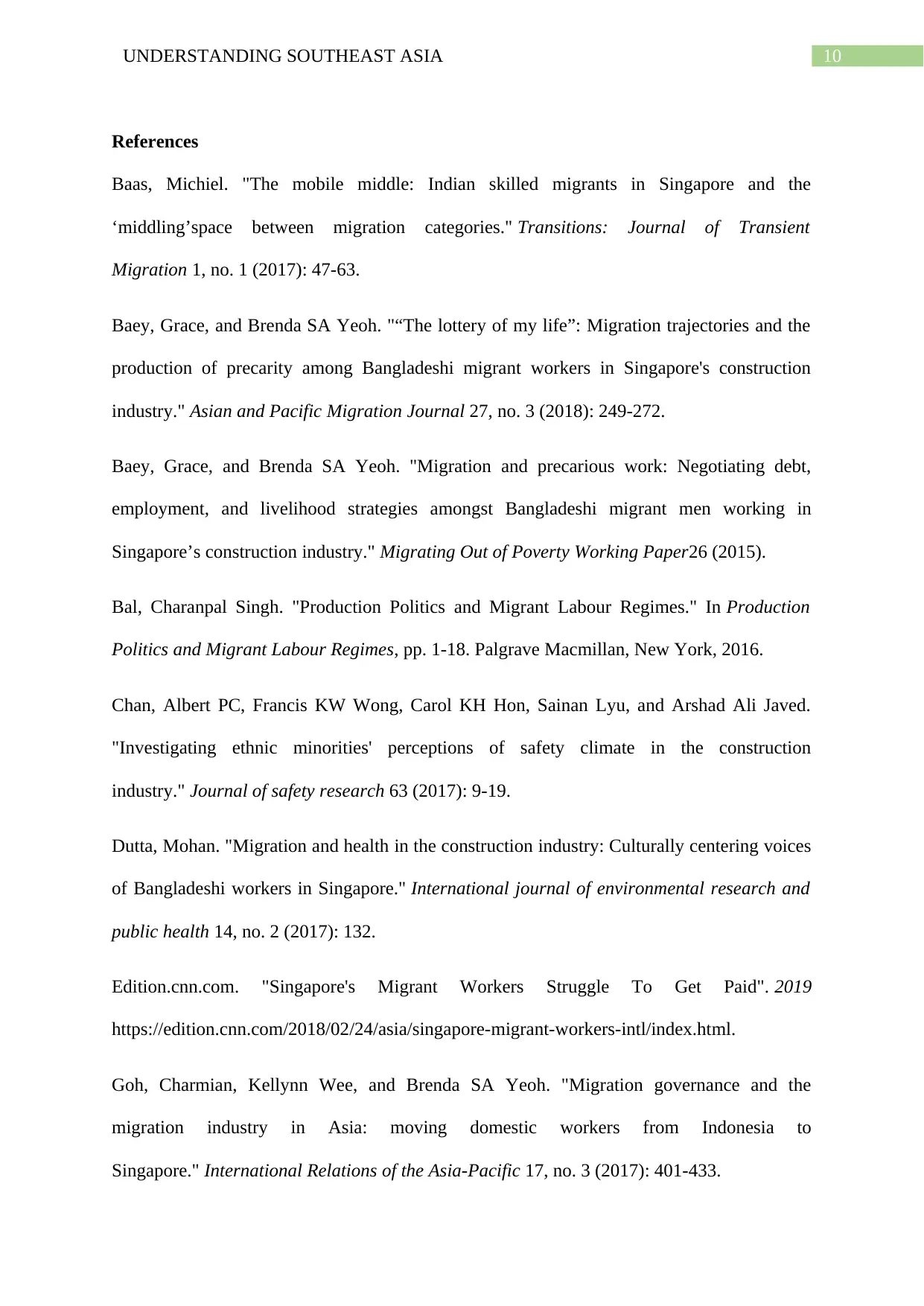
10UNDERSTANDING SOUTHEAST ASIA
References
Baas, Michiel. "The mobile middle: Indian skilled migrants in Singapore and the
‘middling’space between migration categories." Transitions: Journal of Transient
Migration 1, no. 1 (2017): 47-63.
Baey, Grace, and Brenda SA Yeoh. "“The lottery of my life”: Migration trajectories and the
production of precarity among Bangladeshi migrant workers in Singapore's construction
industry." Asian and Pacific Migration Journal 27, no. 3 (2018): 249-272.
Baey, Grace, and Brenda SA Yeoh. "Migration and precarious work: Negotiating debt,
employment, and livelihood strategies amongst Bangladeshi migrant men working in
Singapore’s construction industry." Migrating Out of Poverty Working Paper26 (2015).
Bal, Charanpal Singh. "Production Politics and Migrant Labour Regimes." In Production
Politics and Migrant Labour Regimes, pp. 1-18. Palgrave Macmillan, New York, 2016.
Chan, Albert PC, Francis KW Wong, Carol KH Hon, Sainan Lyu, and Arshad Ali Javed.
"Investigating ethnic minorities' perceptions of safety climate in the construction
industry." Journal of safety research 63 (2017): 9-19.
Dutta, Mohan. "Migration and health in the construction industry: Culturally centering voices
of Bangladeshi workers in Singapore." International journal of environmental research and
public health 14, no. 2 (2017): 132.
Edition.cnn.com. "Singapore's Migrant Workers Struggle To Get Paid". 2019
https://edition.cnn.com/2018/02/24/asia/singapore-migrant-workers-intl/index.html.
Goh, Charmian, Kellynn Wee, and Brenda SA Yeoh. "Migration governance and the
migration industry in Asia: moving domestic workers from Indonesia to
Singapore." International Relations of the Asia-Pacific 17, no. 3 (2017): 401-433.
References
Baas, Michiel. "The mobile middle: Indian skilled migrants in Singapore and the
‘middling’space between migration categories." Transitions: Journal of Transient
Migration 1, no. 1 (2017): 47-63.
Baey, Grace, and Brenda SA Yeoh. "“The lottery of my life”: Migration trajectories and the
production of precarity among Bangladeshi migrant workers in Singapore's construction
industry." Asian and Pacific Migration Journal 27, no. 3 (2018): 249-272.
Baey, Grace, and Brenda SA Yeoh. "Migration and precarious work: Negotiating debt,
employment, and livelihood strategies amongst Bangladeshi migrant men working in
Singapore’s construction industry." Migrating Out of Poverty Working Paper26 (2015).
Bal, Charanpal Singh. "Production Politics and Migrant Labour Regimes." In Production
Politics and Migrant Labour Regimes, pp. 1-18. Palgrave Macmillan, New York, 2016.
Chan, Albert PC, Francis KW Wong, Carol KH Hon, Sainan Lyu, and Arshad Ali Javed.
"Investigating ethnic minorities' perceptions of safety climate in the construction
industry." Journal of safety research 63 (2017): 9-19.
Dutta, Mohan. "Migration and health in the construction industry: Culturally centering voices
of Bangladeshi workers in Singapore." International journal of environmental research and
public health 14, no. 2 (2017): 132.
Edition.cnn.com. "Singapore's Migrant Workers Struggle To Get Paid". 2019
https://edition.cnn.com/2018/02/24/asia/singapore-migrant-workers-intl/index.html.
Goh, Charmian, Kellynn Wee, and Brenda SA Yeoh. "Migration governance and the
migration industry in Asia: moving domestic workers from Indonesia to
Singapore." International Relations of the Asia-Pacific 17, no. 3 (2017): 401-433.
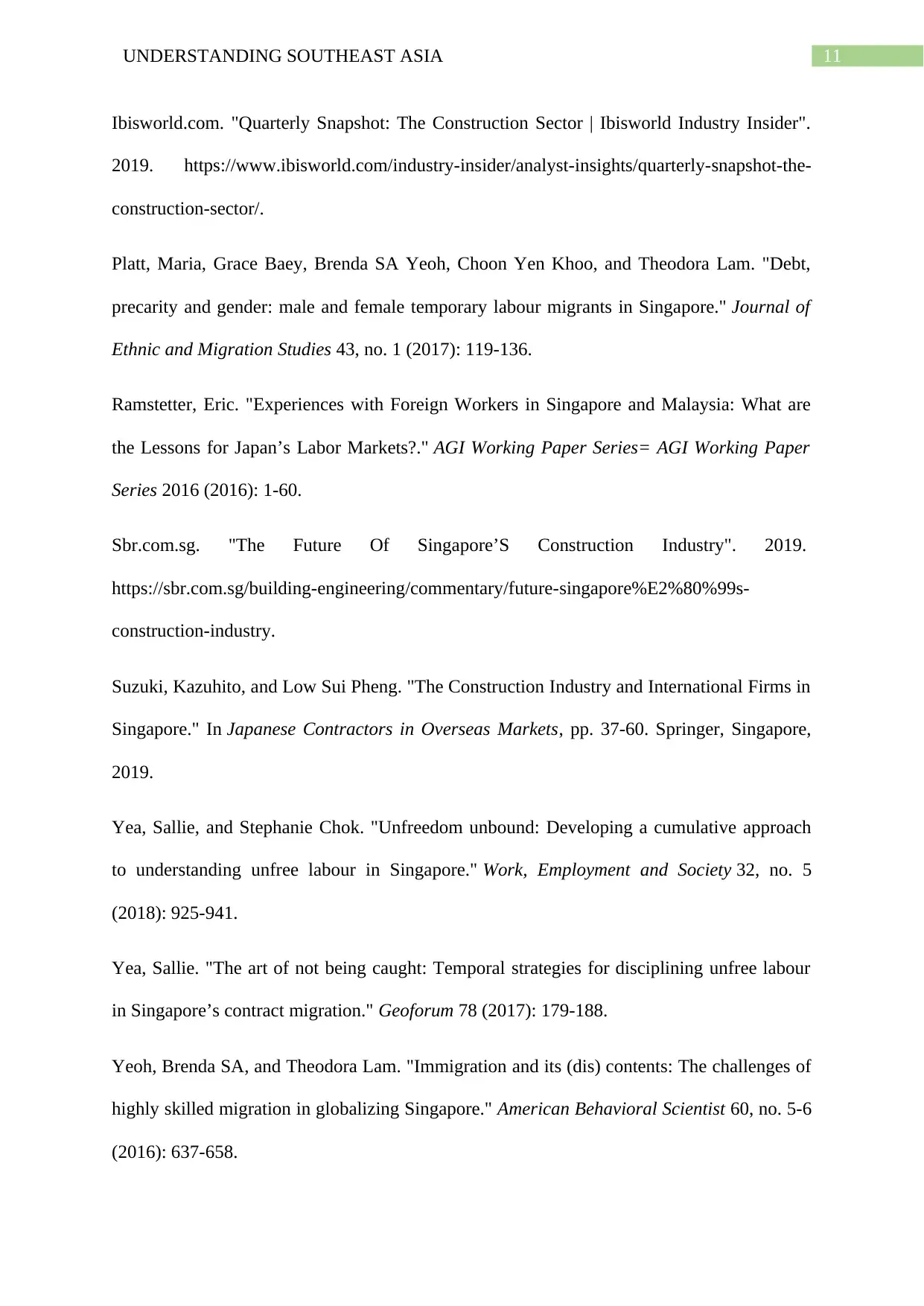
11UNDERSTANDING SOUTHEAST ASIA
Ibisworld.com. "Quarterly Snapshot: The Construction Sector | Ibisworld Industry Insider".
2019. https://www.ibisworld.com/industry-insider/analyst-insights/quarterly-snapshot-the-
construction-sector/.
Platt, Maria, Grace Baey, Brenda SA Yeoh, Choon Yen Khoo, and Theodora Lam. "Debt,
precarity and gender: male and female temporary labour migrants in Singapore." Journal of
Ethnic and Migration Studies 43, no. 1 (2017): 119-136.
Ramstetter, Eric. "Experiences with Foreign Workers in Singapore and Malaysia: What are
the Lessons for Japan’s Labor Markets?." AGI Working Paper Series= AGI Working Paper
Series 2016 (2016): 1-60.
Sbr.com.sg. "The Future Of Singapore’S Construction Industry". 2019.
https://sbr.com.sg/building-engineering/commentary/future-singapore%E2%80%99s-
construction-industry.
Suzuki, Kazuhito, and Low Sui Pheng. "The Construction Industry and International Firms in
Singapore." In Japanese Contractors in Overseas Markets, pp. 37-60. Springer, Singapore,
2019.
Yea, Sallie, and Stephanie Chok. "Unfreedom unbound: Developing a cumulative approach
to understanding unfree labour in Singapore." Work, Employment and Society 32, no. 5
(2018): 925-941.
Yea, Sallie. "The art of not being caught: Temporal strategies for disciplining unfree labour
in Singapore’s contract migration." Geoforum 78 (2017): 179-188.
Yeoh, Brenda SA, and Theodora Lam. "Immigration and its (dis) contents: The challenges of
highly skilled migration in globalizing Singapore." American Behavioral Scientist 60, no. 5-6
(2016): 637-658.
Ibisworld.com. "Quarterly Snapshot: The Construction Sector | Ibisworld Industry Insider".
2019. https://www.ibisworld.com/industry-insider/analyst-insights/quarterly-snapshot-the-
construction-sector/.
Platt, Maria, Grace Baey, Brenda SA Yeoh, Choon Yen Khoo, and Theodora Lam. "Debt,
precarity and gender: male and female temporary labour migrants in Singapore." Journal of
Ethnic and Migration Studies 43, no. 1 (2017): 119-136.
Ramstetter, Eric. "Experiences with Foreign Workers in Singapore and Malaysia: What are
the Lessons for Japan’s Labor Markets?." AGI Working Paper Series= AGI Working Paper
Series 2016 (2016): 1-60.
Sbr.com.sg. "The Future Of Singapore’S Construction Industry". 2019.
https://sbr.com.sg/building-engineering/commentary/future-singapore%E2%80%99s-
construction-industry.
Suzuki, Kazuhito, and Low Sui Pheng. "The Construction Industry and International Firms in
Singapore." In Japanese Contractors in Overseas Markets, pp. 37-60. Springer, Singapore,
2019.
Yea, Sallie, and Stephanie Chok. "Unfreedom unbound: Developing a cumulative approach
to understanding unfree labour in Singapore." Work, Employment and Society 32, no. 5
(2018): 925-941.
Yea, Sallie. "The art of not being caught: Temporal strategies for disciplining unfree labour
in Singapore’s contract migration." Geoforum 78 (2017): 179-188.
Yeoh, Brenda SA, and Theodora Lam. "Immigration and its (dis) contents: The challenges of
highly skilled migration in globalizing Singapore." American Behavioral Scientist 60, no. 5-6
(2016): 637-658.
⊘ This is a preview!⊘
Do you want full access?
Subscribe today to unlock all pages.

Trusted by 1+ million students worldwide
1 out of 13
Your All-in-One AI-Powered Toolkit for Academic Success.
+13062052269
info@desklib.com
Available 24*7 on WhatsApp / Email
![[object Object]](/_next/static/media/star-bottom.7253800d.svg)
Unlock your academic potential
Copyright © 2020–2025 A2Z Services. All Rights Reserved. Developed and managed by ZUCOL.

